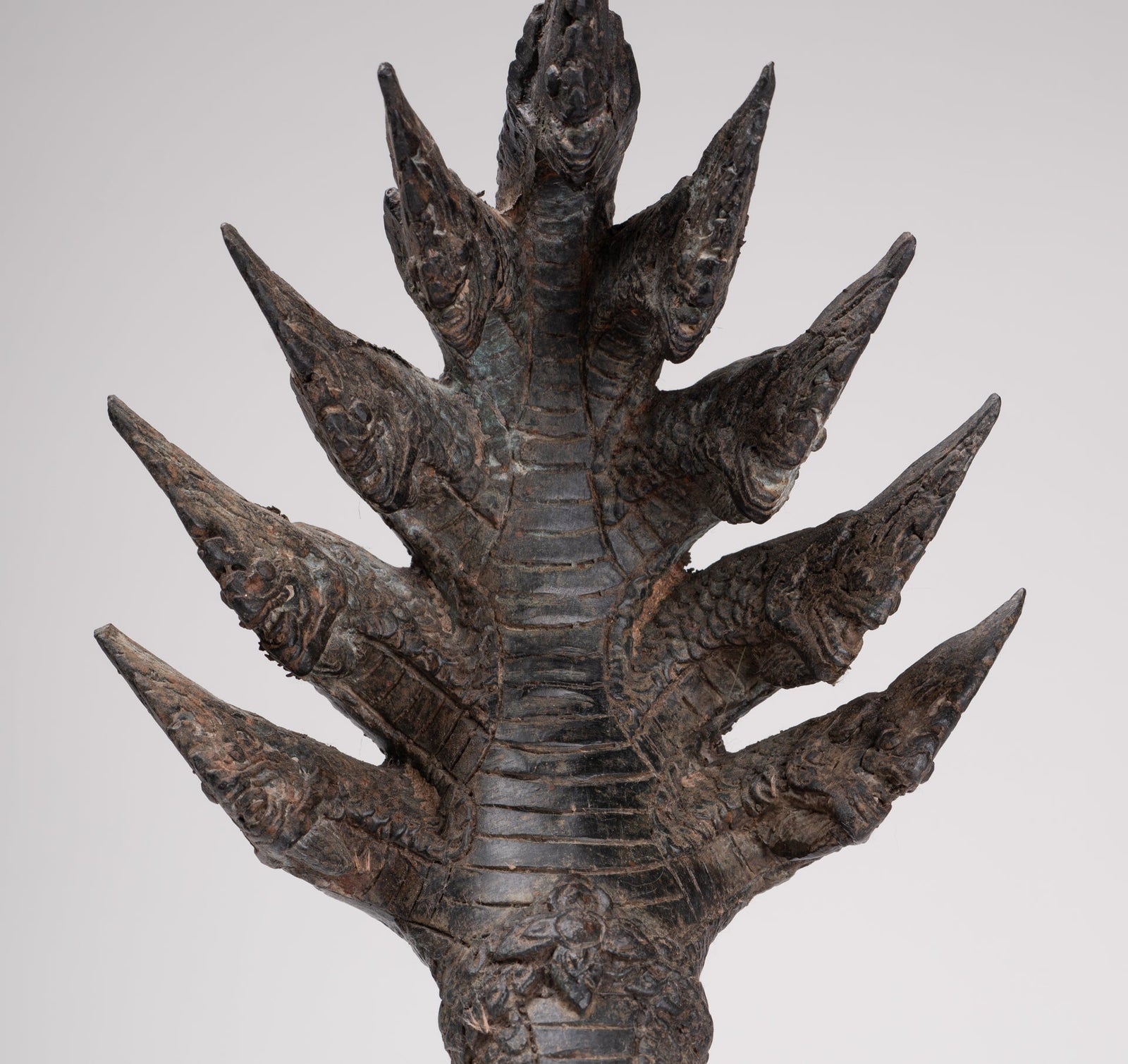
El papel de la mucalinda en el arte budista: el rey serpiente como guardián de la iluminación
Una de las imágenes más poderosas y duraderas del arte budista es la representación del Buda que medita serenamente mientras está protegida por una serpiente masiva y de múltiples cabezas.
Esta figura es Mucalinda, El Rey Naga, una deidad protectora que desempeña un papel vital en la iconografía budista en todo el sur y sudeste de Asia. La imagen majestuosa, misteriosa y profundamente simbólica, de Mucalinda, se ha convertido en una encarnación artística de la reverencia de la naturaleza por el despertar espiritual.
La leyenda de Mucalinda
Según el Vinaya Pitaka Y otros textos budistas tempranos, poco después de que Siddhartha Gautama alcanzara la iluminación debajo del árbol de Bodhi, permaneció en una meditación profunda durante varias semanas, reflexionando sobre la verdad que se había dado cuenta. Durante el sexta semana, surgió una gran tormenta: las razas cayeron en torrentes, los vientos aullaron y los cielos se oscurecieron. A medida que se desataban los elementos, el rey Naga Mucalinda se levantó de su morada acuosa debajo de la tierra.
En un gesto de protección sublime, Mucalinda reunió su enorme cuerpo en un asiento, levantando al Buda sobre las aguas de las inundaciones, y luego desplegó sus múltiples capuchas para formar un dosel de refugio sobre la cabeza del Buda. Cuando la tormenta cesó, Mucalinda reanudó su forma de serpiente, rindió homenaje al iluminado y regresó a su reino debajo de la tierra.
Este momento de tutela elemental se ha convertido en una escena icónica en el arte budista, evocando una profunda conexión entre naturaleza, espiritualidad y el poder de la paz interior.
Simbolismo de mucalinda en el pensamiento budista
La historia de Mucalinda conlleva múltiples interpretaciones simbólicas, cada una de las cuales se expresa a través de la forma artística:
1. Protección del dharma:
Mucalinda representa el fuerzas de la naturaleza y el universo reuniéndose para proteger el Buda recién despierto y, por extensión, el Verdad del dharma. De esta manera, él no es simplemente una serpiente sino un guardián divino de la iluminación.
2. Serenidad en medio de la agitación:
A pesar de la violencia de la tormenta, el Buda permanece tranquilo y compuesto, un testimonio visual y espiritual del poder de quietud interna. Mucalinda amplifica esto al actuar como una fuerza estabilizadora, reforzando el estado mental inquebrantable del Buda.
3. Unión de naturaleza e iluminación:
La serpiente, a menudo asociada con la energía primaria y el inframundo, se inclina en reverencia a la realización espiritual. Esto representa armonía entre el mundo natural y la mente iluminada—Un tema prevalente tanto en la filosofía y el arte budista.
4. Renaje y transformación:
Como serpiente, Mucalinda también simboliza transformación y regeneración, temas comunes en las tradiciones religiosas indias. Su cuerpo en espiral refleja la naturaleza cíclica de la vida y el potencial para renacimiento espiritual.
Mucalinda en arte budista
La imagen del Buda protegido por Mucalinda Aparece en una amplia gama de estilos y materiales en todo el mundo budista, con cada cultura agregando su propio sabor artístico y simbólico.
India (primeras representaciones)
Las primeras representaciones artísticas de Mucalinda aparecen en sitios budistas indios como Sanchi y Bharhut, a menudo en tallas de alivio. Aquí, el Buda aún no se representa antropomórficamente, sino a través de símbolos como el trono vacío o huellas, con el Naga mostrado enrollado debajo del asiento y las campanas de arriba.
Por el Período de Gupta (siglo I -XVI), las imágenes antropomórficas del Buda se volvieron más comunes, y la mucalinda se muestra típicamente como un Naga de siete cabezas, enrollado y abarrotando sus capuchas detrás de la cabeza del Buda como un paraguas.
Camboya y el imperio jemer
En arte jemer, particularmente durante el Período de Angkor, El Buda Mucalinda se convirtió en una de las formas escultóricas más emblemáticas. Aquí, el Buda se representa típicamente en un sereno Dhyana mudra (postura de meditación), sentada en el cuerpo enrollado de una naga, a menudo con Siete o nueve cabezas Arqueado por encima de la cabeza protegida.
El estilo a menudo es monumental, con un destello dramático en las capuchas de Naga. Los artistas jemer renderizaron esta forma en piedra, creando esculturas de templo que aún resuenan con las seriedad espiritual hoy. El Período de bayón vio ejemplos especialmente refinados, donde la plataforma Naga enrollada parece casi como trono.
Tailandia y Laos
En Tailandia, particularmente en Isaan y a lo largo del Río Mekong, Las representaciones del Buda protegidas por Mucalinda son frecuentes y veneradas. En el arte budista tailandés, la serpiente puede haber Siete o nueve cabezas, y el estilo a menudo es más adornado, con colores vibrantes en madera lacada o escultura de bronce. Mucalinda está estrechamente asociada con Adoración local de Naga, donde las serpientes son veneradas como espíritus y protectores ancestrales del agua.
En los templos budistas, las imágenes de mucalinda a menudo se colocan en salas de meditación, recordando a los devotos de la calma que uno debe mantener ante la adversidad.
Interpretaciones contemporáneas
Hoy, Mucalinda continúa inspirando no solo las formas escultóricas tradicionales sino también interpretaciones modernas en pintura, carpintería e incluso murales del templo. La imagen es especialmente significativa en una era de turbulencia ambiental y psicológica, de pie como un símbolo de Calma, resistencia y el papel sagrado del mundo natural En el despertar espiritual.
El papel de Mucalinda en el arte también se ha extendido a:
-
Amulets y talismanes: Especialmente popular en la cultura budista tailandesa y lao.
-
Imágenes de festival: Particularmente en el Bang Fai Phaya Nak Festivales, donde se celebran los mitos de Naga.
-
Monumentos públicos: Las estatuas a gran escala del Buda Mucalinda son comunes en los complejos y parques del templo.
Conclusión
El papel de la mucalinda en el arte budista trasciende la mera narración. Es un símbolo vivo del poder protector de la naturaleza, la serenidad de la iluminación y el profundo respeto otorgado al Buda a través de los siglos.
A través de innumerables interpretaciones en escultura e iconografía, Mucalinda continúa en bobina alrededor del corazón de la cultura visual budista, lo que nos recuerda que la paz puede existir incluso a los ojos de la tormenta.


